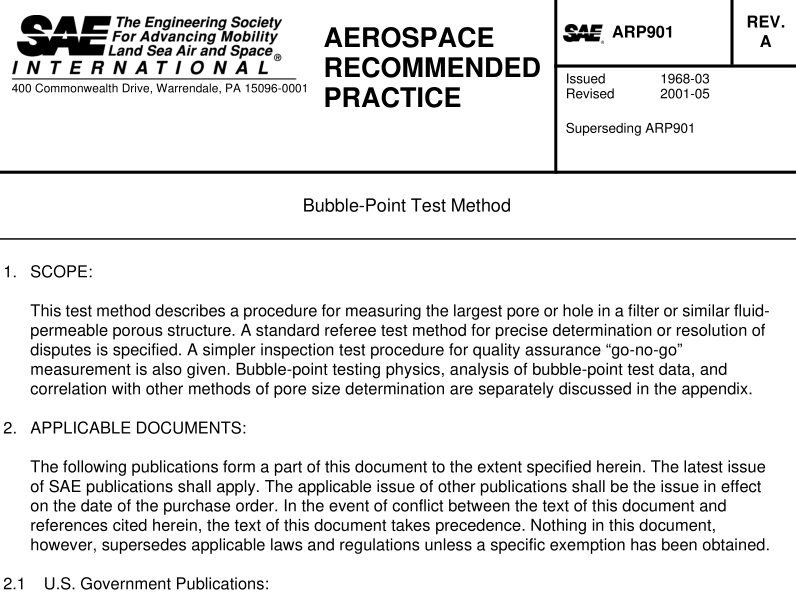SAE ARP 901A:2001 pdf download Bubble-Point Test Method
1 . SCOPE: This test method describes a procedure for measuring the largest pore or hole in a filter or similar fluid- permeable porous structure. A standard referee test method for precise determination or resolution of disputes is specified. A simpler inspection test procedure for quality assurance “go-no-go” measurement is also given. Bubble-point testing physics, analysis of bubble-point test data, and correlation with other methods of pore size determination are separately discussed in the appendix.
2. APPLICABLE DOCUMENTS: The following publications form a part of this document to the extent specified herein. The latest issue of SAE publications shall apply. The applicable issue of other publications shall be the issue in effect on the date of the purchase order. In the event of conflict between the text of this document and references cited herein, the text of this document takes precedence. Nothing in this document, however, supersedes applicable laws and regulations unless a specific exemption has been obtained.
2.1 U.S. Government Publications:
Available from DODSSP, Subscription Services Desk, Building 4D, 700 Robbins Avenue,Philadelphia, PA 1 91 1 1 -5094.
MIL-H-5606 Hydraulic Fluid, Petroleum Base; Aircraft; Missile and Ordnance
MIL-PRF-5624 Turbine Fuel, Aviation, Grades JP-4, JP-5, JP5/JP-8 ST
MIL-E-51 454 Ethyl Alcohol, (Ethanol)
3. METHOD OUTLINE: The filter is immersed in a test liquid which wets and saturates the filter pore structure. Gas pressure is applied to one side of the porous wall so that the liquid phase which wets the pores is displaced by the gas. The gas pressure is slowly increased until the first steady stream of gas bubbles is observed to emit from a point on the porous surface. The measured gas pressure required to form the “first bubble” is essentially equal to the pressure force which is in equilibrium with the surface tension force at the largest pore. This bubble-point pressure is a relative measure of the pore size after appropriate corrections for immersion depth and test liquid surface tension have been made.
4. REFEREE TEST: Capillary pressure or “bubble-point” tests have long been used to measure the largest pore and characterize the pore size distribution of various porous materials. Many different methods of testing and analysis have been developed. No bubble-point test measures actual pore size, but only allows correlation of the measured capillary pressure with some dimensional characteristic of the pore structure. Rationalization of bubble-point test data depends on detailed definition of the test method, analysis and correlation employed. Therefore, a standard referee test is necessary to assure common interpretation of data and understanding of specifications.
4.1 Test Equipment: Suitable bubble-point test equipment includes a source of clean compressed air or nitrogen with provisions for regulating and measuring the gas pressure. A test liquid container and appropriate fixtures for sealing and holding the test element are also required. Further provisions for maintaining system cleanliness may be desirable, especially for Clean Room operations, but they are not generally required for ordinary testing. A suitable apparatus for typical filter elements is shown schematically in Figure 1 and requires the following components or their functional equivalent.
SAE ARP 901A:2001 pdf download
